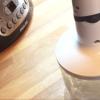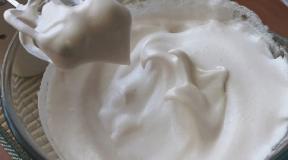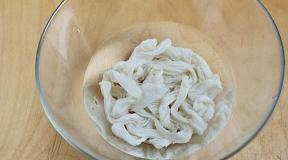Bacterial lysates: what they are, features and applications. Bacterial lysates Bacterial lysate can appear in inoculum
Bacterial l izates are very unusual drugs, the mechanism of action of which is most similar to vaccination. In essence, they are immunomodulators. Most often, bacterial lysates are prescribed for the prevention and treatment of respiratory infections in frequently ill children and adults.
The first preparations containing bacterial lysates appeared at the end of the 19th century *, but their widespread use began only in the 70s of the last century. They are often prescribed in the Russian Federation, although recently there have been a lot of studies carried out in Western Europe(some of them are indicated at the end of the article). From time to time, lysates are called "drugs with unproven effectiveness", referring to the fact that there are too many domestic publications on them (and we do not accept trust in Russian scientific articles). However, if one is guided only by European studies, it is difficult to conclude about their absolute effectiveness or ineffectiveness: there are studies that have proven their effectiveness, there are those that equate their effect with placebo. Perhaps the situation will change when EMA will update its recommendations. These drugs have ATC codes J07A X, L03AX, R07AX. They are authorized and sold in Germany, Austria, Czech Republic, Luxembourg, Romania, Slovakia, Portugal, Greece, Italy and other EU countries. Whether this is a sufficient reason for the doctor to prescribe these drugs, only the doctor can decide. Patients have the right to refuse the appointment (and this article is for informational purposes only).
What are these drugs?
Not all immunomodulators are drugs: for example, the BChC vaccine belongs to the first generation microbial drugs (the company is owned by Pirogenal and Prodigiosan, which are currently not used due to pronounced side effects). Bacterial lysates "IRS 19", "Broncho-munal", "Broncho-Vaxom", "Ismigen", "Imudon", "Ribomunil", which will be discussed below, belong to the second generation of microbial immunomodulators; they are drugs.
These preparations contain inactivated strains of bacteria most commonly found in respiratory infections **. They have a slight antibacterial effect, but unlike antibiotics, they do not kill microflora, but form immunity to specific strains of bacteria. But most importantly, bacterial lysates act on various links of immunity, stimulating local (cellular and humoral) and systemic immune responses, due to which they are able to increase the general resistance of the body to seasonal viral diseases and have a preventive effect. The role of lysates in the prevention of bacterial infections is most likely insignificant.
Bacterial lysates are common and local action.
- The general action is possessed by "Broncho-munal", "Immunovac", "Ribomunil" and others. Their preventive effect is higher, since they affect humoral immunity.
- Local lysates - "IRS 19", "Imudon" - increase the concentration of protective proteins sIgA and increase the phagocytic activity of macrophages. They mainly affect the local immunity of the mucous membranes.
Bacterial lysates can be prescribed even in the acute period of the disease and combined with antibacterial therapy... If we are talking about lysates of local action (usually they are released in the form of sprays), then falling on the surface of the mucous membrane of the upper respiratory tract, they form a uniform layer on it, which creates suitable conditions for the absorption of the drug. Local bacterial lysates increase the amount of secretory immunoglobulin sIgA, which protects mucous membranes and prevents microorganisms from "settling" on them; in addition, they stimulate the Pirogov-Waldeyer's lymphoepithelial ring ***. Generally acting drugs form a systemic immune response by activating T- and B-lymphocytes, as well as macrophages (cells that attack infectious microorganisms).
pros
- Bacterial lysates do not cause the formation of resistant microorganisms;
- Do not destroy beneficial microflora and do not disrupt intestinal function;
- Have wide range bacterial action(the doctor can prescribe them without preliminary tests);
- Relatively safe (contraindications and side effects they have much less than antibiotics);
- Their use causes the formation of a selective immune response against specific pathogens and has a prophylactic effect;
- Bacterial lysates can mitigate the course of the disease, reduce the incidence of SARS and relapses within 6-12 months.
- In some cases, they reduce the need for antibiotic therapy.
Minuses
- Topical drugs (IRS 19) are less effective than systemic drugs (Broncho-munal), because the time of their contact with the mucous membrane is short, and therefore the time of capture of the mucous part of antigenic substances is insignificant. Also, washing with saliva oral cavity, interferes with constant contact of the drug with immunocompetent cells.
- The duration of the antibacterial protection provided by lysates is not reliably known (most likely it varies from several months to a year).
- This class of drugs is not well studied, and their use in world practice is limited, there are disputes about their effectiveness.
- Bacterial lysates require long-term therapy: from several weeks to 3 months.
MCan bacterial lysates be used instead of vaccines?
In the usual sense, it is unlikely. Of course, lysates can be called vaccines, but rather weak, requiring constant courses. Perhaps their short-term effectiveness is due to the fact that topical preparations are quickly washed off the mucous membranes and have a short effect on the immune mechanisms, while lysates of general action, although they enter the intestine, can cause an insufficiently strong immune response.
Efficiency
According to studies that have recognized their effectiveness, bacterial lysates **** reduce the incidence of ARVI in frequently ill children on average by 42%, in addition, they reduce the likelihood
bacterial complications in case of illness. The similar effectiveness of these drugsalso demonstrated in other age groups (schoolchildren and adults) and in asthmatics.
The use of bacterial lysates is effective in both children and adults with recurrent upper respiratory tract diseases (sinusitis, otitis media, acute rhinitis and pharyngo-laryngitis); in children who are often ill at the age of 3-6 years with chronic tonsillitis and adenoiditis. "Broncho-munal" and "Broncho-Vaxon" are effective for the prevention of relapses chronic bronchitis, in addition, they reduce the frequency and severity of relapses in children with asthma.
Operating principle(using the example of the two most popular drugs: IRS 19 and Broncho-Munal)
- "IRS 19" (local bacterial lysate, available as a spray) . Getting on the mucous membrane, the drug causes defensive reactions, similar to those that develop in response to the introduction of pathogenic microorganisms. The mobilization of defense mechanisms begins a few minutes after it hits the surface of the mucous membrane: the level of sIgA immunoglobulins increases, from which a protective film is formed, which prevents the penetration and fixation of microorganisms; the number of immune cells increases. IRS 19 activates phagocytosis, increases the levels of lysozyme, opsonins, complement and interferon production. All this reduces the number of opportunistic microorganisms in the oropharynx and enhances local immunity. And most importantly, "IRS 19" acts locally, so it has a minimum number of side effects "().
- "Broncho-munal "(bacterial lysate of general action, available in the form of tablets). This drug withstimulates the activity of macrophages against infectious agents and tumor cells,affects the activity of B cells, NK cells and T helper cells. Also heincreases the amount of secretory immunoglobulin IgA *** andconcentration of immunoglobulins IgG, IgM and IgA in blood plasma. When applying it, the decreasesuppressor activity of T-lymphocytes and serum IgE concentration ().
Application
Why do children get sick often?
The high susceptibility of children to various viruses is primarily due to the immaturity of their immune system and the lack of previous contacts with pathogens. In addition, young children have a rather low level of formation of interferons and their anti-infectious activity.Phagacytosis (inactivation of pathogensphagacites), although it has increased activity, is unfinished, and the barrier functions of the skin and mucous membranes of the respiratory tract are not effective enough. The maturation of specific immune defenses - T- and B-lymphocytes - occurs in a child until puberty. The synthesis of its own immunoglobulins IgG will reach the level characteristic of adults by about 6-8 years. The amount of IgA immunoglobulins, which provide local protection of mucous membranes (including the intestines), in newborns and children is 3-4 times lower than in adults, and reaches the required level at 6-10 years.
science journalist, editor-in-chief of the online parenting magazine Mommy's Mag.
Thank the doctor, uh
expert in personalized and preventive medicine, Yulia Yusipova and micro and molecular biologist Andrey Panov for help in preparing the material.
Checked and updated 11/15/2018
Sources:
1. V.K. Tatochenko, N.A. Ozeretskovsky "Immunoprophylaxis-2014"
2. Bacterial lysate medicines article 31 referral notification (2018)
3. Bacterial lysate for the prevention of chronic rhinosinusitis recurrence in children The Journal of Laryngology & Otology (2017)
4. Prevention of respiratory tract infections with bacterial lysate OM-85 bronchomunal in children and adults: a state of the art Multidisciplinary Respiratory Medicine (2013
)
5. "The place of bacterial lysates in the treatment of recurrent bacterial infections" (2014)
6. "Bacterial lysates in the treatment and prevention of respiratory diseases in children" (2011)
7. "Prospects for the use of bacterial lysates in respiratory diseases" (2009)
8. "Bacterial lysates. New drugs" (2014)
9. "The place of bacterial lysates in the treatment of recurrent bacterial diseases" (2013)
10. "The effectiveness of topical bacterial lysate in the treatment and prevention of acute respiratory infections" (2010)
11. "The place of lysates of bacteria OM-85 (Broncho-munal) in the prevention and treatment of diseases in children" (2016)
12. "Experience in the use of bacterial lysates in the clinical practice of a pediatrician and otorhinolaryngologist" (2012)
13. "Clinical efficacy of bacterial lysates used in the treatment of children and adolescents after adenotonsillectomy" (2011)
14. "Immunoregulatory and immunostimulatory responses of bacterial lysates in respiratory infections and asthma" (2015)
15. "Study on clinical effect and immunologic mechanism of infants capillary bronchitis secondary bronchial asthma treated with bacterial lysates Broncho-Vaxom" (2016)
16. "Nonspecific immunomodulators for recurrent respiratory tract infections, wheezing and asthma in children: a systematic review of mechanistic and clinical evidence" (2018)
17. Cochrane Review: Immunostimulants for preventing respiratory tract infection in children (2012)
18. "The use of a mixture of bacterial lysates in children of the first year of life with repeated bacterial infections of the respiratory tract and ENT organs" (2009)
Footnotes:
* In 1891, William Coley established the relationship between the transferred infection (scralatine, erysipelas) caused by Streptococcus pyogenes, and tumor regression in patients. In 1893, he created a vaccine based on Streptococcus pyogenes for the treatment of patients with sarcoma. Bacteria were later added to the vaccine Serratia marcescens, which enhanced its anti-tumor properties. Despite the large number of reports of the successful use of the "cancer vaccine", it has received huge criticism because many doctors did not believe these results. A skeptical attitude towards Kolya's work, as well as the development of radio and chemotherapy, led to the gradual discontinuation of the use of this vaccine. However, modern immunology proved that William Coley's principles were correct, and that some forms of cancer are indeed sensitive to the increased immune load on the body, which was the reason for the effectiveness of his vaccine. As research in this area is currently very active, William B. Coley received the title of "Father of Immunotherapy" (Wikipedia).
** In the oropharynx, patients with frequent and long-term illnesses usually thrive Str. pneumoniae (25-30%), H. influenzae (15-20%), M. catarrhalis (15-20%), Str. pyogenes(2-3%), representatives of gram-negative microflora and various viruses
*** The lymphatic pharyngeal ring belongs to the peripheral organs of the immune system. It consists of two palatine tonsils, two tubal tonsils located in the area of the auditory tubes; pharyngeal tonsil, lingual tonsil, lymphoid granules and lateral lymphoid ridges on the posterior pharyngeal wall.
**** Since topical drugs are less effective, general-acting drugs are more often prescribed to children with frequent illnesses.
Preferanskaya Nina Germanovna
Associate Professor of the Department of Pharmacology, Faculty of Pharmacy, I.M. THEM. Sechenov, Ph.D.
BACTERIAL LYSATES FOR INFECTIOUS INFLAMMATORY DISEASES
ENT ORGANS AND RESPIRATORY TRACT
Broncho-Munal- a mixture of lyophilized bacterial lysates in capsules (Broncho-Munal P 3.5 mg and Broncho-Munal 7 mg) - contains lysates of the following bacteria - Moraxellacatarrhalis, used for the prevention and in combination therapy of infectious and inflammatory diseases of the bronchopulmonary system. The lyophilisate of the lysates is preserved by freezing followed by drying in a vacuum. Children aged 6 months to 12 years are allowed to use only the drug "Broncho-Munal P" 3.5 mg; adults and children over 12 years old - Broncho-Munal at a dose of 7 mg - 1 time per day, in the morning on an empty stomach ( daily dose- 1 caps.).
The drug reduces the incidence, duration and severity of the disease, helping to reduce the dose of antibiotics and other drugs.
The immune response is realized through the recognition receptors of the nasopharyngeal lymph ring to the pulmonary alveoli. Increases humoral and cellular immunity, providing an immunomodulatory effect. The drug stimulates the activity of alveolar macrophages, peripheral monocytes, increases the number of circulating T-lymphocytes, increasing their number and activity, and increases the production of cytokines. On the mucous membranes of the respiratory tract and through the Peyer's patches of the digestive tract, the concentration of secretory IgA increases, the production of protective adhesive molecules, IgA, IgG and IgM antibodies increases. In the blood, the concentration of IgE antibodies decreases. When taking the drug, the body's natural defense mechanisms against respiratory tract infections are stimulated, their frequency and severity of the course decrease.
Broncho-Munal is used as prophylactic with chronic infectious diseases of the upper and lower respiratory tract, in particular with chronic bronchitis, tonsillitis, pharyngitis, laryngitis, rhinitis, sinusitis, otitis media. Broncho-Munal is prescribed as an adjunct drug for all diseases of the respiratory tract and for recurrent infections of ENT organs, purulent and unspecified otitis media. When using the drug, body temperature may rise, allergic reactions and dyspeptic disorders may occur.
Broncho-Vaxom(Broncho-Vaxom adult 7 mg and Broncho-Vaxom child 3.5 mg, capsule gelatin.) - standardized lyophilisate of bacterial lysates Haemophilus influenzae, Streptococcus pneumoniae, Streptococcus viridans, Streptococcus pyogenes, Staphylococcus aureus, Klebsiella pneumoniae, Klebsiella ozaenae,Moraxellacatarrhalis, under the influence of these antigens, the body's immune defense is stimulated, and the resistance to infections of the respiratory system increases. The drug has a powerful stimulating effect on most types of white blood cells, increases the number of circulating B-lymphocytes and triggers the necessary biological reactions that increase the body's resistance to infections. The action of the drug is based on the activation of immune defense cells and is mediated through the intestinal lymphatic system. The effect is manifested through antigen-presenting cells in Peyer's patches small intestine... Activated B-lymphocytes enter the bloodstream and are carried throughout the body. Immunopharmacological studies have shown that in humans, the effective amount of cytokines increases, the formation of IgA secreted by the mucous membrane of the respiratory tract and saliva, and the selective production of polyclonal IgG antibodies in serum increases. Activation of natural killer cells, metabolic and functional activity of macrophages is observed, however, there is no increase in the complement component C 3 and C-reactive protein.
Broncho-Vaxom is used to prevent recurrent respiratory tract infections and exacerbations of chronic bronchitis, which helps to reduce the incidence of infections and shortens the duration of their course. Included in complex treatment acute infections respiratory tract, which undoubtedly reduces the likelihood of exacerbations chronic course these diseases. For the treatment of acute and exacerbation of chronic respiratory infections, it is prescribed to children aged 6 months to 12 years. If it is difficult for a child to swallow the capsule, open it and mix the contents with liquid food or drink. Children over 12 years of age and adults are administered orally 1 capsule daily on an empty stomach until symptoms disappear, within 10 days. For the prevention of exacerbations and maintenance therapy, 1 capsule is used daily in the morning on an empty stomach. The course of treatment includes 3 cycles, each of which consists of a daily intake of the drug for 10 days, the interval between cycles is 20 days. The duration of treatment is determined by the doctor on the basis of the individual condition of the patient, if necessary, it is combined with antibiotic therapy.
Important! Side effects when applied are mild and amount to 3-4%. Manifest in the form of gastrointestinal disorders (nausea, abdominal pain, vomiting), skin reactions (itching), respiratory system disorders (cough, shortness of breath), as well as headache, feeling of fatigue. Contraindication is hypersensitivity to the components of the drug.
Ribomunil does not apply to preparations based on bacterial lysates, however, in its own way pharmacological action very similar to them. The drug is a ribosomal-proteoglycan complex, which includes the most common causative agents of ENT-organs and respiratory tract infections ( Streptococcus pneumoniae, Streptococcus pyogenes, Staphylococcus aureus, Klebsiella pneumoniae, Haemophilus influenzae) and refers to stimulants of specific and nonspecific immunity. The ribosomes that make up Ribomunyl contain antigens that are identical to the surface antigens of bacteria, and when ingested, they cause the formation of specific antibodies to these pathogens. Membrane proteoglycans stimulate nonspecific immunity, which is manifested in an increase in the phagocytic activity of macrophages and polynuclear leukocytes, an increase in nonspecific resistance factors. The drug stimulates the function of T- and B-lymphocytes, the production of serum and secretory immunoglobulins such as IgA, interleukin 1, as well as alpha and gamma interferons.
Ribomunil is used in complex therapy, which makes it possible to increase the effectiveness and shorten the duration of treatment, significantly reduce the need for antibiotics, bronchodilators, and increase the period of remission. Used for treatment chronic diseases and recurrent infections of ENT organs (otitis media, rhinitis, sinusitis, pharyngitis, laryngitis, tonsillitis) and respiratory tract infections (chronic bronchitis, tracheitis, pneumonia, infectious-dependent bronchial asthma). It is recommended to be taken for prophylaxis before the start of the autumn-winter season, especially in ecologically unfavorable regions, as well as often and long-term ill children and the elderly. The drug is prescribed 1 time per day in the morning on an empty stomach. Single dose(regardless of age) is 3 tablets of 0.25 mg (with 1/3 of a single dose) or 1 tablet of 0.75 mg (with one dose), or granules from one sachet, previously dissolved boiled water room temperature.
For children early age(from 6 months) Ribomunil is recommended to be administered in the form of granules. In the first month of treatment and / or with preventive purpose the drug is taken daily for the first 4 days of each week for 3 weeks. During the next 2-5 months - the first 4 days of each month. It is recommended to carry out three-month prophylactic courses of treatment 2 times a year, six-month prophylactic courses - once a year.
BACTERIAL LYSATES FOR INFECTIONS IN UROLOGY
Uro-Waxom- lyophilized bacterial lysate of 18 strains Escherichiacoli, available in 6 mg capsules, is used for infections urinary tract... In the body, it stimulates T-lymphocytes, induces the formation of endogenous interferon, increases the IgA content in the urine. Stimulates the metabolic and functional activity of macrophages, promotes the release of various lymphokines: IL-2, IL-6, TNF. Prevents the development of infections, has a stimulating effect on macrophages, immunocompetent cells in Peyer's patches and B-lymphocytes, increases the IgA content. Clinical studies have shown that the drug reduces the frequency of recurrence of urinary tract infections, especially cystitis.
The drug is included in combination treatment, is used to prevent recurrence of chronic urinary tract infection, especially cystitis, regardless of the nature of the microorganism, in combination with antibiotics or antiseptics. When treating acute cases used daily in the morning on an empty stomach, 1 cap., as an additional drug during conventional antimicrobial therapy until the symptoms disappear, but not less than 10 days. The maximum treatment period is 3 months. Prevention and treatment of infections that are difficult to treat - 1 caps daily on an empty stomach in the morning. also within 3 months. The duration of treatment and the appointment of a repeated course of therapy should be determined by the doctor, based on the patient's state of health.
Individuals may experience minor gastrointestinal (diarrhea, nausea, vomiting), skin (pruritus, exanthema, erythema) disorders and limited allergic skin reactions. Rarely mild fever.
BACTERIAL LYSATES FOR INFECTIONS IN GYNECOLOGY
Floragin- a mixture of lactobacilli lysates ( L. Bulgaricus, L. Acidophilus, S. Termophilus, B. Bifidus,L. Helveticus,L. Plantarum and L. Casei), available in the form of vaginal suppositories "Floragin Ovuli" 2 g No. 6, vaginal gel "Floragin Gel" bottle 9 ml No. 6 and solution "Floragin Solucio" 140 ml. Lysates of lactobacilli are stabilized with an extract of seaweed, which has a softening and soothing effect, effectively eliminates itching. Lactic acid, which is included in the composition, provides the required pH level (3.5-4.5) of the vaginal area. Lysate strains act together, normalizing the vaginal microflora and creating a protective effect to suppress the growth of pathogenic microflora, as well as to normalize the physiological pH level of the vaginal mucosa.
Suppositories are designed to prevent disorders of the vaginal microflora, normalize the vaginal microflora and the physiological pH level of the vagina, are prescribed for vaginal dryness, irritation, burning, itching and vaginitis, to improve local vaginal immunity, have a restorative, normalizing and soothing effect. When vulvovaginal candidiasis ("thrush") is used to restore the microflora of the vagina simultaneously with systemic drugs.
The gel is intended for daily prevention of disorders or normalization of the vaginal microflora and restoration of the physiological state of the vaginal mucosa; it is used for vaginal dryness and irritation during menopause, if bad smell and profuse discharge, with burning and itching caused by disorders menstrual cycle, stress, taking antibiotics, contraceptives or other drugs. Application: 1 fl. per day intravaginally. It is produced in the form of a disposable soft polyethylene bottle with an applicator containing 9 ml of gel (6 bottles in a cardboard box.). As a prophylactic agent - 1 vial. a day for 6 days.
Gel "Floragin" is not recommended for use during attempts at conception. Low levels of vaginal acidity negatively affect sperm activity, thereby making it difficult to conceive. It is not recommended to use the gel as a contraceptive either.
"Floragin Solucio" in the form of a solution is intended for intravaginal administration in order to normalize the vaginal microflora in a short time, reduce the risk of fungal infections of the external genital organs and vagina, incl. caused by Candida albicans... Recommended for use after each sexual contact and in the postmenstrual period.
The use of these drugs allows you to control, maintain and restore the natural balance of the vaginal microflora, the natural pH level, softens and heals the vaginal mucosa. Important! Their use is permitted during pregnancy and lactation. Long-term use can cause local reactions in the form of hypersensitivity and irritation. If any of the listed side effects persist, you should discontinue use and consult your doctor.
BACTERIAL LYSATES FOR INFECTIONS IN PROCTOLOGY
Posterisan, Posterisan forte(ointment and suppositories) contains different amounts of inactivated microbial cells Escherichiacoli... In one gram of the ointment, about 330 million E.coli cells are injected into the anus using an applicator daily in the morning, before bedtime and after bowel movements. One rectal suppository contains about 660 million E. coli cells. Solid emulsifying fat, hydroxystearate and glycerin-acrogol, etc. are used as auxiliary substances. Both the ointment and the Posterisan suppositories have anti-inflammatory, regenerating, immunostimulating, and antipruritic effects. The use of the drug helps in the formation of both nonspecific and specific immunity. The suspension of inactivated bacteria and the products of their metabolism, which is part of the suppositories and ointment Posterizan, has a pronounced effect on the T-system of the immune system of the human body. Under influence active ingredients the activity of leukocytes and cells of the reticuloendothelial system increases. It is intended for the treatment of diseases affecting the anorectal region (anal fissures, itching, burning, hemorrhoids, anopapillitis). The drug interacts with the rectum and skin areas of the anogenital area, increases the resistance of local tissues to the adverse effects of pathogenic microflora, promotes tissue regeneration, reduces vascular exudation in inflammatory processes, increases and restores their permeability.
Important! When using immunostimulating drugs, caution should be exercised in persons with hypersensitivity, should not be used in acute intestinal diseases, pregnant women (especially in the first trimester) and mothers during lactation.
The drug is dispensed with a doctor's prescription.
Included in the list medicines prescribed by a doctor with the provision of additional free medical care certain categories of citizens who have the right to receive state social assistance.
COMMERCIAL NAMES
Broncho-Vaxom adult, Broncho-Vaxom for children, Broncho-munal, Broncho-munal P.FORM OF MEDICINAL PREPARATION
Capsules.HOW DOES THE PREPARATION WORK?
Bacterial lysates mixture refers to immunostimulating agents. The drug reduces the frequency and severity infectious diseases.IN WHAT CASES IS A MEDICINAL PRESCRIBED?
With respiratory tract infections as part of a comprehensive treatment.With recurrent respiratory tract infections: chronic bronchitis, tonsillitis, pharyngitis, laryngitis, rhinitis, sinusitis, otitis media.
APPLICATION OF THE PREPARATION
RECEPTION RULESTake 1 capsule orally.
DURATION OF RECEPTION
In the acute period of the disease, it should be taken for at least 10 days.
Prophylactically prescribed 3 courses of 10 days at intervals of 20 days.
WHEN MISSING A DOSE
If you miss, take your medication as soon as you remember. If the time is close to taking the next capsule, skip the dose and continue using the medicine on the same schedule. Do not take a double dose of the drug.
EFFECTIVE AND SAFE TREATMENT
CONTRAINDICATIONSHypersensitivity.
SIDE EFFECTS
Allergic reactions (rash, itching, burning, swelling of the skin), abdominal pain, nausea, diarrhea, vomiting, fever.
IT IS NECESSARY TO INFORM YOUR DOCTOR
You are taking any other drug, including over-the-counter drugs, herbs, and dietary supplements.
Have you ever had allergic reaction for any drug.
If you are pregnant
The drug is contraindicated.
If you are breastfeeding
The drug is contraindicated.
If you suffer from other medical conditions
No dosage change is required.
If you are over 60 years old
No dose reduction is required.
If you are giving the drug to children
Do not prescribe the drug to children under 6 months of age.
INTERACTIONS
Use with other medicines
Reduces the absorption of certain drugs, including digoxin, isoniazid, tetracycline.
Alcohol
Alcohol reduces the effectiveness of the treatment.
STORAGE RULES
Should be stored at room temperature in a dry, dark place, out of the reach of children.
Acute respiratory diseases (ARI) prevail in the structure of the general morbidity in children and account for 50-60%. The main cause of most acute respiratory infections is respiratory viruses and the influenza virus, however, more than half of the children, due to the fear of activation of the bacterial flora against the background viral disease antibiotics are prescribed. Viral infection is often complicated by the development of bacterial superinfection of exogenous or endogenous origin. Relevance of irrational use of antibacterial drugs in acute respiratory viral infections(ARVI) is associated with the possibility side effects antibiotics, the spread of resistant strains of pneumotropic bacteria and, in addition, unnecessary treatment costs.
The bacterial etiology of acute respiratory infections in children, as in adults, is relatively rare, but it is this that poses the greatest threat to the development of serious complications. Bacterial acute respiratory infections are caused by a relatively small number of pathogens, mainly vegetating in the upper respiratory tract (Table 1). These are pneumococci, group A hemolytic streptococcus, capsular haemophilus influenzae ( H. influenzae) and etc. .
Young children have a high susceptibility to pathogens of acute respiratory infections, which is due to the immaturity of the child's immune system, a small number of previous contacts with viruses, low level formation and activity of interferons, imperfect nature of phagocytosis, insufficient barrier function of the skin and mucous membranes of the respiratory tract, low levels of secretory IgA. In this connection, the antiviral protection is weakened, the adhesion and penetration of the pathogen is facilitated. Despite the frequency of respiratory infections in children, it is important that they are easy and not accompanied by the development of complications.
The maturation of specific immune defenses, T- and B-lymphocytes, occurs in a child for a long time, up to puberty. The immunological protection received from the mother (Ig predominantly of class G) is completely eliminated by 6-9 months of the child's life, while the synthesis of its own immunoglobulins G will reach the adult level only by 6-8 years, immunoglobulins A - by 10-12 years. Therefore, the risk of developing ARVI in children is increased by such factors as the unfavorable course of pregnancy, prematurity, intrauterine infection, artificial feeding and others. Carriage of opportunistic bacterial flora can also serve as a reservoir of infection.
Thus, transient changes in the child's immune system lead to frequent acute respiratory infections, but are not a sign of immunodeficiency, but are most often associated with high level contacts with sources of infection. In the conditions of a children's collective, group immunity to a number of pathogens is formed, as indicated by a high percentage of carriage in the absence of diseases.
In children with frequent recurrent diseases of the respiratory tract, signs of immune imbalance and insufficient reserve immunity are often revealed. The consequences of frequent respiratory diseases there may be violations of the functional activity of the immune system and the formation of chronic inflammatory processes in the respiratory organs. Considering the above, the prevention of recurrent respiratory diseases in children who are often and for a long time ill is relevant. An individualized approach to vaccine prophylaxis, hardening is required, and it is possible to prescribe preventive courses of immunomodulatory drugs.
The most effective and targeted method of preventing respiratory infections is vaccination against the main pathogens, such as pneumococcus, Haemophilus influenzae, influenza virus. Unfortunately, however, there are many more respiratory pathogens than existing vaccines. In addition, respiratory pathogens are characterized by rapid variability, and specific immunity against them is short-lived. Therefore, drugs that affect the creation of specific immunity against a specific infectious agent? respiratory tract are of great importance.
In recent years, immunocorrectors of bacterial origin have been actively used for the treatment and prevention of respiratory diseases, primarily bacterial lysates, which cause the formation of a selective immune response against the most common bacterial pathogens, which also activate non-specific mechanisms innate immunity, which help fight both bacteria and viruses. Bacterial lysates were developed in order to prevent infectious diseases of the upper and lower respiratory tract and are a mixture of antigens obtained from various inactivated bacteria, which is a pathogen-associated molecular agent that leads to a cascade of local immune responses and stimulates the immune response through recognition receptors. Bacterial lysates have a dual purpose: specific (vaccinating) and non-specific (immunostimulating).
Exists various drugs systemic (Broncho-munal, Broncho-Vaxom) and local (IRS 19, Imudon) action based on bacterial lysates.
The mechanisms of action and effectiveness of systemic and topical immunotropic agents are different. Insufficient effect of local immunomodulators may be associated with a short contact time and insufficient uptake of the drug with mucous membranes due to constant flushing of the oropharyngeal segment with saliva.
Bacterial lysates have a number of specific properties at all stages of the immune response, due to which the effectiveness of their use is much higher. The mechanism of action is to stimulate the processes of phagocytosis and antigen presentation, enhance the production of anti-inflammatory cytokines (IL-4, IL-10, TRF), and develop an adjuvant effect. Moreover, this mechanism turns out to be the most physiological, since bacterial lysates stimulate own reactions organism on the effect of the antigen and do not cause unnecessary additional effects. Along with the production of specific antibodies to the pathogens included in the preparations, they also stimulate nonspecific immunity - the production of secretory IgA, interleukin-1 and α-interferon, cytokines, NK cells, cells of the macrophage-phagocytic system, etc. increases.
In numerous clinical research it was shown that the use of immunotherapy with bacterial lysates leads to a decrease in the incidence of acute respiratory viral infections and their complications, and a decrease in the severity of their course.
V pediatric practice bacterial lysate of systemic action OM-85 ( tradename Broncho-munal, Broncho-Vaxom), which has been proven to be effective and safe in numerous clinical studies with a high level of evidence. OM-85 contains lyophilized lysate of the most common causative agents of acute respiratory diseases: Streptococcus pneumoniae, Klebsiella pneumoniae, Staphylococcus aureus, Streptococcus pyogenes, Branchamella catarralis, Haemophilus influenzae, Klebsiella ozaenae, Streptococcus viridans and can be used in children from 6 months of age (pediatric forms of release with a dosage of bacterial lysate 3.5 mg).
When using lysates of systemic action (OM-85), the development of a specific immune response occurs with the cooperation of T- and B-lymphocytes, macrophages or dendritic cells, after the ingestion of antigen-stimulated cells with surface immunoglobulin A into the lymphoid organs. Subsequently, specific immunoglobulin A is again transported to the surface of the mucous membranes, preventing invasion infectious agents, their adsorption, phagocytosis and the formation of immune complexes. At the same time, activation cytotoxic T lymphocytes leads to the destruction of infected cells.
According to modern concepts, the pharyngeal and palatine tonsils are not only an independent anatomical unit, but also a part of the MALT system (Mucosa-associated lymphoid tissue). The antigens of bacterial lysates, in contact with the macrophages of the MALT system of the tonsils, respiratory and gastrointestinal tracts, are subsequently presented by lymphocytes, resulting in the appearance of clones of B-lymphocytes that produce specific antibodies to pathogens, the antigens of which are contained in the preparation. The migration of B-lymphocytes to other lymphoid formations of the MALT system and their subsequent differentiation into plasma cells lead to the production of specific secretory IgA and the development of effective local immune defense against the main causative agents of acute respiratory diseases. These mechanisms contribute to a decrease in the frequency of carriage of pathogenic and opportunistic flora and the degree of contamination of the tonsils with it by more than 50% when using OM-85.
Immunological studies indicate that the obvious anti-infectious effect of the OM-85 bacterial lysate is, in addition to an increase in the level of specific antibodies, an increase in IgA levels both in the blood serum and in the secretions of the respiratory tract. IgA is fixed on mucous membranes, supports their barrier function, interacts with specific antigens of bacteria. The drug improves the parameters of humoral and cellular immunity through Peyer's patches in the intestinal mucosa, stimulates peritoneal macrophages. When it is used in the blood serum, the number of T-lymphocytes, IgA, IgG, IgM increases.
The studies also demonstrated the effect of OM-85 on the activation of CD16 + cells, an increase in the functional activity of macrophages, the production of a number of cytokines and mediators (IL-6, IL-8, IL-2, γ-IFN). At the same time, there is an increase in the production of α-interferon, a decrease in the levels of IL-4, TNF-α, and an increase in the level of IgG enhances the intercellular interactions of macrophages, natural killers. These shifts can be interpreted as a switch of the Th2-type immune response to the Th1-type (Fig. 1).
.gif)
By stimulating a specific and nonspecific immune response, the use of OM-85 in children with recurrent respiratory diseases helps to reduce the incidence of acute respiratory infections, and reduces the likelihood of bacterial complications. A number of studies have shown a 2-fold reduction in the number of exacerbations of chronic pharyngitis and otitis media when using OM-85.
Also in children with allergic diseases when OM-85 is included in complex therapy, not only a decrease in the frequency of episodes of respiratory infections, but also manifestations of bronchial obstruction is noted, which can be useful for the prevention of exacerbations in patients with bronchial asthma. OM-85, in addition, increases the functional activity of alveolar macrophages against infectious and tumor antigens, NK cells "natural, natural killers", reduces the production of IgE. In children with bronchial asthma and frequent intercurrent acute respiratory diseases, the use of OM-85 promotes clinical improvement in 68% of cases. The incidence of acute respiratory infections with symptoms of bronchial obstruction during the year is reduced by more than 2 times. The number of severe asthma attacks and the child's annual need for bronchodilators are reduced. At the same time, there is an increase in the level of interferon gamma, a decrease in total immunoglobulin E and circulating immune complexes in the blood.
The activation of a nonspecific immune response when using bacterial lysates allows them to be successfully used in the complex therapy of acute respiratory infections. Studies have shown that the use of OM-85 reduces the percentage of intracranial complications from the paranasal sinuses and ear in young children.
The appointment of OM-85 for the prevention of recurrences of chronic bronchitis reduces the frequency and severity of relapses, reduces hospitalizations by 1.43 times, and its duration by 1.8 times. In children with chronic rhinosinusitis, there was a decrease in the frequency of relapses and the severity of symptoms. In children with frequent and long-term illnesses, when OM-85 is prescribed, the frequency of acute respiratory infections, pharyngitis, and bronchitis decreases 2-3 times.
Bacterial lysates can be prescribed in the acute period of the disease and for prophylactic purposes. In the acute period of respiratory infections, the administration of drugs is more effective in combination with etiotropic therapy. In pediatric practice, children's forms OM-85 is used, which contains half adult dose bacterial lysate (0.0035 g).
For the prevention of infectious diseases of the respiratory tract, the drug is used in three 10-day courses with 20-day intervals between them. The effect of systemic immunomodulators (OM-85) lasts for 6 months, which is important for determining the interval between courses. In children with frequent recurrent diseases during the year, two three-month courses for 10 days every month are shown.
It is possible to use the drug for treatment: in the acute period of the disease, 1 capsule / day is prescribed until the symptoms of the disease disappear, but not less than 10 days. In the next 2 months, prophylactic use of the drug in 1 caps is possible. within 10 days with a 20-day interval between courses. In young children, the contents of the capsule are dissolved in a small amount of liquid (milk, tea, juice).
Thus, OM-85 affects various links of the immune response, stimulates cellular and humoral immunity, which in children with frequent recurrent diseases leads to a decrease in the frequency and severity of infections, the need for antibiotics. OM-85 is effective in the treatment and prevention of infectious diseases of both the upper and lower respiratory tract.
Literature
- An Integrated Approach to the Treatment and Prevention of Acute Respiratory Infections in Children: A Practical Guide for Physicians / Ed. prof. N.A.Geppe, prof. A. B. Malakhova. M., 2012.47 p.
- Simon H. B. Bacterial infections of the upper respiratory tract // ACP Medicine. 2010.
- Samsygina G.A. Frequently ill children: problems of pathogenesis, diagnosis and therapy // Pediatrics. 2005, No. 1, p. 66-74.
- Petrov R.V. Vaccination against influenza: problems and successes // Treating Doctor. 2007. No. 9, p. 20-24.
- Ivanova N.A. Systemic bacterial lysates: mechanism of action and indications for use // Consilium Medicum. Pediatrics. 2015; 02: 29-32.
- Malkoch A.V., Anastasevich L.A., Botkina A.S. Acute respiratory diseases and the possibilities of immunomodulatory therapy // Attending Physician. 2008. No. 5. S. 16-23.
- Malakhov A.B., Kolosova N.G., Khabibullina E.V. Bacterial lysates in programs for the prevention of respiratory infections in children // Practical Pulmonology. 2015, No. 4, p. 16-19.
- Del-Rio-Navarro B. E., Espinosa Rosales F., Flenady V., Sienra Monge J. J. L. Immunostimulants for preventing respiratory tract infection in children // Cochrane Database Syst Rev. 2996; 4: CD004974.
- SteurerStey C., Lagler L., Straub D. A., Steurer J., Bachmann L. M. Oral purified bacterial extracts in acute respiratory tract infections in childhood: a systematic quantitative review // Eur. J. Pediatr. 2007. Vol. 166, No. 4. P. 365-376.
- Cisney E. D., Fernandez S., Hall S. I., Krietz G. A., Ulrich R. G. Examining the Role of Nasopharyngealassociated Lymphoreticular Tissue (NALT) in Mouse Responses to Vaccines // J. Vis. Exp. 2012. Vol. 66. P. 39-60.
- Bogomilskiy M.R. The value of bacterial immunocorrection in the treatment of diseases of the ear, nose and throat in children // Difficult patient. 2007.10.S. 26-32.
- Schaad U. B. OM85 BV, an immunostimulant in pediatric recurrent respiratory tract infections: a systematic review // World J. Pediatr. 2010. Vol. 6, No. 1. P. 5-12.
- Rozy A., Chorostowska Wynimko J. Bacterial immunostimulants - mechanism of action and clinical application in respiratory diseases // Pneumonol. Alergol. Pol. 2008. Vol. 76, No. 5. P. 353-359.
- Razi C. H., Harmanci K., Abaci A., Özdemir O., Hizli S., Renda R., Keskin F. The immunostimulant OM85 BV prevents wheezing attacks in preschool children // J. Allergy Clin. Immunol. 2010. Vol. 126, No. 4. P. 763-769.
- Sprenkle M. D., Niewoehner D. E., MacDonald R., Rutks I., Wilt T. J. Clinical efficacy of OM85 BV in COPD and chronic bronchitis: a systematic review // COPD. 2005. Vol. 2, No. 1. P. 167-175.
N. G. Kolosova, Candidate of Medical Sciences
GBOU VPO First MGMU them. I.M.Sechenov, Ministry of Health of the Russian Federation, Moscow
Reading time: 5 minHaving bought a new remedy for the treatment of, for example, colds, almost everyone examines the instructions for its use. And, having read the composition of the medicine, they ask themselves what exactly is a bacterial lysate.
On the one hand, the agent should relieve inflammation, and on the other, it contains bacteria.
But as you know, bacteria are useful and harmful. That is, speaking in an accessible language, good and bad. In modern medicine, even the "bad" bacteria are beneficial. An example of this is the lysis of pathogenic microorganisms.
Speaking about bacterial lysates, it is necessary to understand what they are and what are their benefits?
Lizates - these are the split bacteria Enterococcus faecium, Enterococcus faecalis and Escherichia coli and other causative agents of oral diseases.
The cell walls of bacteria interact with the human body and activate immune system... Unlike the bacteria Enterococcus faecium and Enterococcus faecalis themselves, lysates cannot cause inflammation, since these are no longer living microorganisms. But the body is perceived as pathogenic bacteria, as a result of which they stimulate the immune system.
Bacterial lysates belong to a separate group of immunomodulatory drugs.
They are divided into three types:
- purified bacterial lysates;
- bacterial ribosomes;
- immunostimulating membrane fractions.
Each medicinal product contains a certain set and number of fragmented pathogenic microorganisms. Lysates are both immunomodulatory and vaccinating agents.
Respiratory Diseases

During the period of colds, it is difficult not to catch acute respiratory infections, not only for children, but also for adults. Preparations containing a lot of bacterial lysates have become an excellent solution for a quick recovery.
After drugs containing bacterial lysates enter the mucous membranes, cells are activated that can not only destroy the virus, but also protect against the further spread of pathogenic bacteria.
If we subject the lysates to drying, we get lyophilizates. The freeze-drying process itself is called lyophilization.
The action of lyophilized bacterial lysates is in many ways similar to the action of antiviral vaccines. They also stimulate the immune system to start producing antibodies, which in turn will protect the mucous membrane from infection. In addition, a microorganism that once got on the nasopharyngeal mucosa will behave differently.
The human body will be ready to fight back the disease faster than before prophylaxis with bacterial lysates. The antibodies produced when taking lysates will protect the body from a severe course of the disease.
Genitourinary system

This problem concerns the overwhelming majority of the female population. Many women often face diseases such as cystitis and urethritis.
Even in spite of not always pronounced unpleasant symptoms, it is definitely not worth leaving these diseases to chance. Complications will not keep you waiting and will take a very serious form of the disease. In addition, an infection in the urinary system can spread to the kidneys, and then, it will be expensive and time-consuming to recover.
The culprit of such unfortunate diseases and consequences is the bacterium Escherichia coli. But modern pharmaceuticals have turned the harm of this bacteria to their advantage. This happened through the technology of lysis. Scientists have obtained a lyophilized lysate of the bacterium Escherichia coli, which is able to prevent cystitis and inflammation of the urinary tract. And in case of infection, cure the disease. Medicines are prescribed in the form of capsules, as well as drops and suppositories.
In addition to taking medications, it is imperative to follow the personal hygiene and diet prescribed by the attending physician.
Female beauty

In the 21st century, bacteria can not only contribute to the development of disease or heal, but also help preserve the beauty of the skin. Not so long ago, a new probiotic cream for the skin around the eyes appeared on the cosmetology market, based on the already known bacterial lysates.
In addition to bacterial lysates, the cream contains many vitamins, amino acids and cosmetic oils that are beneficial for the skin of the face.
Testing has shown that the skin of the eyelids becomes smoother, "bruises" and swelling disappear. The female half, who has experienced this cream on herself, enthusiastically speaks of its properties and positive effect. In addition, the cream is well absorbed and has a pleasant sweet aroma.
How to treat

There are various preparations of general and local action based on bacterial lysates. The effectiveness of the action depends on the correct diagnosis and the choice of the treatment regimen.
Ismigen- the first bacterial lysate created by mechanical lysis. Helps in the treatment and prevention of the respiratory tract. The composition of the medication includes 6 of the most common pneumococci. Ismigen acts by activating phagocytosis, increasing the number of cells responsible for immunity. With the use of ismigen, as a preventive measure for the development of diseases of the upper and lower respiratory tract, a decrease in the severity and duration of the disease was noted. The prophylactic course should be carried out at least once a year.
Imudon- consists of particles of inactive microorganisms found in pathological inflammation of the oral cavity. Its use increases the level of lysozyme in saliva and activates plasma cells. As a result, immunity increases not only at the site of action of the drug, but also in the body as a whole. It is used to treat the oral mucosa and diseases in the field of dentistry.
IRS-19- used for the treatment of the upper respiratory tract with bronchitis, acute respiratory viral infections, as well as after surgical interventions on the ENT organs. The drug is used nasally as a spray.
Broncho-Vaxom- lyophilized bacterial lysate of systemic action. Activates innate immunity by acting on cells located in the intestinal lymphoid tissue. The drug is considered safe, even for children from 6 months of age, well tolerated and highly effective.
Release form

Preparations containing lysates are produced in many forms:
- capsules;
- ointments;
- cream;
- drops;
- suppositories for rectal use.
For the treatment of respiratory problems, tablets and sprays work well. They envelop the mucous membrane of the larynx well and prevent pathogenic bacteria from reaching the respiratory tract.
Lysates can usually be used with antibiotics. In the case of joint administration, treatment is significantly accelerated.
There are many preparations containing lysates. It is important to remember that treatment must be prescribed by a qualified doctor who will draw up a detailed treatment plan and prescribe the correct dosage of the medication.
Otherwise, if received incorrectly, adverse reactions such as nausea, vomiting, diarrhea, allergies and fever, and headache.



















